Divers will travel far and wide to find the best diving. But those who live in the United States have plenty of great diving on their doorstep as well, with plentiful access to the Atlantic Ocean, the Pacific Ocean and the Gulf of Mexico. From warm-water reefs to temperate seas, here are some of the top places to scuba dive in the United States.
Monterey Bay, California
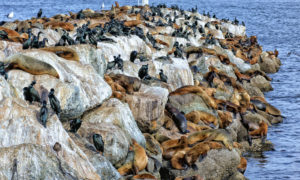
Monterey Bay National Marine Sanctuary contains Point Lobos State Marine Conservation Area, one of the richest marine habitats in California. This pristine area, particularly Whaler’s Cover and Bluefish Cove, allows no more than 30 divers per day, so advance online reservations are necessary. This dive restriction results in a beautiful site, with several sightings you may not find at other California locations, such as harbor seals, abalone, leopard sharks and rock cod. Conditions are typically favorable year-round and navigation easy is thanks to the rock formations running parallel to the beach. During the day, check all the nooks and crannies for eels, shrimp and juvenile fish, and watch for hunting nudibranchs on night dives.
With its clear water and sheltered coves, Monterey Bay is accessible to all levels of diver. Water temperatures ranging from 50 to 60 F (10 to 15 C) even in the summer, so you’ll want a drysuit. Visibility ranges from 10 to 30 feet (3 to 9 m).
Santa Catalina Island, California
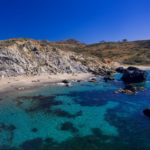
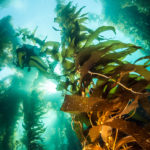
There are several sites around Catalina, but Ship Rock is one of the best. Two miles off the coast, the site features garibaldi, sheepshead, Pacific octopus, leopard sharks, and angel sharks swimming among the kelp. Ship Rock’s underwater topography provides ledges and canyons that draw pelagics, such as yellowtail tuna and sunfish. It’s worth the trip, as visibility is much better than closer to shore and the kelp forests are extremely healthy and very large. Since depths range from 20 to 135 feet (6 to 40 m) and visibility ranges from 40-100 feet (12 to 30 m), this site is good for all dive levels. You’ll want a drysuit or thick wetsuit however, as water temperatures range from 55 to 72 F (13 to 22 C).
Channel Islands, California
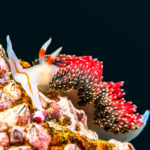
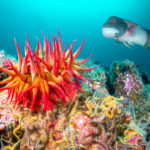
The islands of San Miguel, Santa Rosa, Santa Cruz, Anacapa and Santa Barbara make up the Channel Islands National Park, where cold, nutrient-rich currents from the north mix with warm water from the south. This creates an extremely bio-diverse environment with consistently good visibility. In fact, many dive operators cater specifically to photographers because of the water clarity. California sea lions and harbor seals are ready for their close-ups and a variety of nudibranchs and garibaldis make for colorful shots. Thick, towering kelp forests provide wide-angle seascapes and you are likely to see rays, giant sea bass, black sea bass and small wrecks. Santa Rosa and San Miguel are best for advanced divers because the winds make for more challenging conditions, but Cathedral Cove on Anacapa is a highlight for all diving levels. Water temperatures range from 55 to 70 F (13 to 21 C).
Southeast Florida
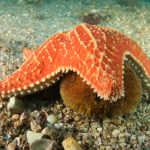
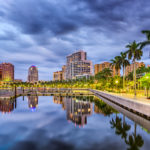
This region offers one of the longest continuous reef structures in the West Atlantic, with 23 miles running from Miami to Fort Lauderdale and Palm Beach. The Gulf Stream current flows close to shore here, providing warm, clear water on the 100 or so reef and wreck sites. Several reefs are accessible via shore dives, and since both the reefs and prevailing currents run parallel to shore, drift diving is great. Any dive operation in the area can drop you off at the top and pick you up at the end.
From May to September, it’s common to see a dozen or more turtles riding the current with you. If you keep an eye out to the blue, you may see a shark or sailfish, since the reef is on the migratory path of whales and other big ocean creatures. And one of the nation’s best shallow-water muck dives awaits at Blue Heron Bridge in West Palm Beach. The area is an artificial reef hotbed, as well. Just offshore, a string of wrecks are part of an aggressive artificial-reef program, including three retired oil platforms called Tenneco Towers.
Florida Keys
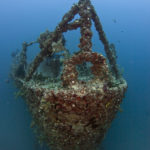
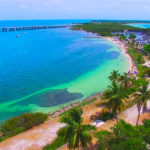
The Florida Keys offer everything from reefs to famous wrecks, many part of the Shipwreck Trail. Wrecks sit in a variety of depths and offer conditions suitable for all divers, beginning with the USS Spiegel Grove and ending with the Vandenberg in Key West. Strong currents are common on the Spiegel Grove, so it’s best for advanced divers. Coast Guard cutters Bibb and Duane, in the same area, are home to barracuda and oceanic jacks and are more suitable for novice divers. Additional wrecks litter the waters all the way to Key West, where the 524-foot (160 m) Vandenberg awaits. Sitting in 45 to 150 feet (14 to 46 m) of water, the wreck is suitable for all levels. This truly massive ship used to track Russian missiles during the Cold War and is the second-largest purpose-sunk wreck in the world.
Morehead, North Carolina
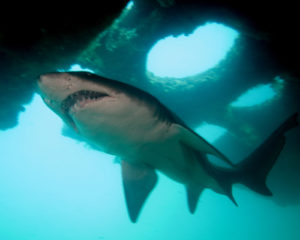
If you’re an intermediate diver who likes sharks and wrecks, Morehead, North Carolina will deliver. Local dive shops conduct day-long charters to the Spar, a sunken 180-foot USCG cutter that is very much intact at 110 feet (34 m). The site is also easy to navigate for those interested in penetration training. And while there are never any guarantees, you are likely to see anywhere between five and 20 sand-tiger sharks, also called “raggies.” Although the raggies are not overly curious, they generally stick around and make for an exhilarating dive. The sharks are drawn here by the Gulf Stream, which delivers an abundance of prey with no need to chum or use other artificial feeding methods. Other nearby wrecks include the Aeolus, Papoose, Atlas, and Caribsea all well-known hangouts for raggies.
Bonne Terre, Missouri
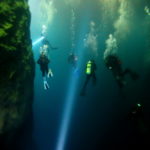
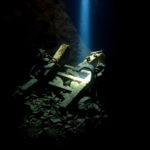
For something completely different, check out the Bonne Terre mine, an hour south of St. Louis. Once used to extract lead to make ammunition, the mine fell into disuse once resources ran out. After the mine was abandoned without packing up or clearing out any mining implements, the area flooded with fresh water. Today you can dive the mine with a guide on any of 24 routes. You’ll find picks and shovels, ore cars, a machine shop, geology lab, offices, a movie theater, and a drinking fountain. Non-divers can take walking and boat tours to explore the 17 miles of “coastline,” while you explore the submerged world in 100-foot visibility. Water temperature is 62 F (17 C) year-round, so bring a thick wetsuit or drysuit.
Flower Garden Banks, Texas
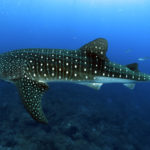
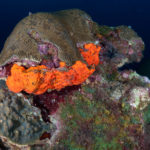
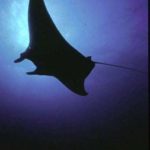
Freeport is your gateway to the Flower Garden Banks. Located 100 miles (160 km) offshore, Flower Garden Banks consist of three banks in the northernmost portion of America’s coral reef system and offers just about every type of fish indigenous to the Gulf of Mexico. Although there’s lots of small stuff, it’s not unusual to see spinner dolphins, silky sharks, whale and hammerhead sharks and manta rays. Coral polyps spawn after the first full moon in August, creating a spectacular underwater spectacle and drawing in thousands of animals to feed.
Because it’s so far offshore it takes eight hours for the boat to reach the reef, and currents can vary from strong to non-existent. Because you cannot bet on the weather, keep your plans flexible if you want to visit Flower Garden Banks. Currents and waves can make for some challenging diving as well as boat exit and re-boarding. Trips are sometimes cancelled at the last minute as well.
Bellingham, Washington
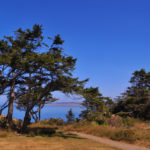
Cold water and strong currents set this area apart from the rest. In fact, those divers unfamiliar with pinpointing slack tides should only dive with an instructor. Either way, you must take special care at the end of the jetty or you could be fighting the outer current and risk being pulled into the path of the local ferry.
Although the currents here are no joke, the diving is worth it. Fort Casey State Park is your entry point where the 250-foot (76 m) Keystone Jetty hosts a wall blanketed with white anemones. You’ve also got a good chance to spot the giant Pacific octopus out of its den here. Other cold-water dwellers you might find on this 45-foot (14 m) dive include wolf eels, lingcod, rockfish, decorator and mossy-head war bonnets, as well as a variety of nudibranchs. Visibility is 10 to 50 feet (3 to 15 m) and the water temperature is 45 to 52 F (7 to 11 C) degrees, so a drysuit is a must.
Puget Sound, Washington
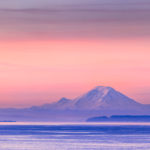
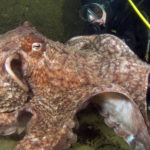
There are more than 75 shore-diving sites in this area just an hour from Seattle, including fjords, rocky reefs, wooden and steel wrecks. Local marine life includes sea lions, giant anemones and killer whales, along with other cold-water dwellers since the water temperature is 50 F (10 C) year-round. Once you are over the shock of the water temperature, head to Edmonds Underwater Park. Start watching at about 30 feet (9 m) for ratfish, a bizarre fish believed to be a link between fish and sharks as they have both bony skeletons and cartilage.
An eight-minute drive from downtown Tacoma, at Point Defiance, is one of the country’s best wall dives, Dead Man’s Wall. This sheer sandstone face starts at 90 feet (27 m) and is a habitat for giant Pacific octopus, skates and lingcod. Day Island Wall is on the other side of Point Defiance. Divers have fed wolf eels here, so don’t be surprised if they approach. The wall is also full of invertebrates like sunflower stars, kelp crabs and anemones. Bring drysuit and dive during the fall and winter while the algae is dormant for the best visibility.
Baranof Island, Alaska
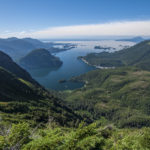
If you’re interested in jellyfish diving, Smudges is the place to do it. You will have to find an operator to get you to the site, though, as it is slightly offshore. Though the presence of jellies can be seasonal due to current shifts and temperature changes, if you go during the summer, you should see massive colonies of harmless moon jellies that extend to a depth of 80 feet. When you’re not diving, you can experience true Alaska, as your view will include a high-sided fjord with a snow-covered glacier and waterfalls, as well as potential grizzly bear sightings.
Lake Huron, Michigan
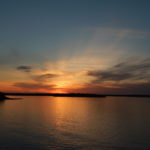
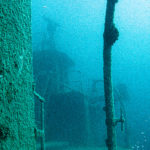
The Presque Isle coastline is 65 miles (104 km) long but has only a few lighthouses. This may be why the area has claimed 75 ships, including a steel steamer, a wooden steamer, and three intact and upright schooners. Fifty of the ships are in Thunder Bay National Marine Sanctuary, where visibility can reach 50 feet (15 m). Shipwreck Alley features the Cornelia B. Windiate in 180 feet (55 m) of water, with its three masts still intact and tattered rigging flowing in the water.
In Grand Traverse Bay Underwater Preserve you can see the Metropolis, a schooner lost in a snowstorm in 1886. The debris field ranges in depths of only 8 feet up to 120 feet (2 to 36 m) of water. Another schooner, the Yuba, sits in only 15 feet (4.5 m) of water and is a great dive for beginners. Wreck diving possibilities in the area are nearly endless.
From cold-water locations to the warm waters of Florida, each of these sites has unique characteristics and marine life. With them all right here in the United States, at least a few should make it onto your bucket list.
The post Top Places to Scuba Dive in the United States appeared first on Scuba Diver Life.
from Scuba Diver Life https://ift.tt/2HMvSpH
I appreciate the information, well thought out and written.
ReplyDeleteessay helo online